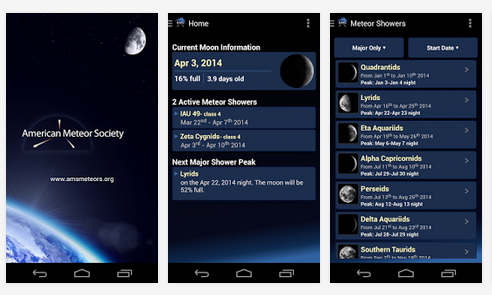
How to use the American Meteor Society’s smartphone app (iOS and Android) to create observer reports of fireballs and meteors during the Camelopardalids this weekend.
Coming soon to a sky near you: a brand new meteor shower!
Barring all cloudy conditions and light-polluted landscapes, you should be able to bear witness to the Camelopardalids this Friday, May 23, 2014 (going into the morning of Saturday, May 24, 2014).
As Earth orbits the sun, sometimes it passes through the stream of debris left by a comet. If the timing is just right, the debris enters the atmosphere and create trails of light in the sky, more colloquially referred to as “shooting stars.” Alas, they aren’t stars at all but tiny pieces of pebble, rock, and grains as fine as sand.
The comet responsible for this shower is 209P/LINEAR, which was discovered in 2004 by Lincoln Near-Earth Asteroid Research, for which it’s nicknamed. It came to closest to our sun (perihelion) on May 6, 2014, but it’ll miss Earth by about 8.3 million kilometers (about 5 million miles) at its closest on May 29, 2014. Don’t worry — we’re not in any danger from it…this time around.
What you can do while you watch the Camelopardalids
The American Meteor Society invites you to report fireball and meteor sightings with their smartphone app and browser-based field logger. The smartphone app allows witnesses to log details about their observations using a mobile device, meaning you can take it with you to your preferred viewing locations — your backyard, a hiking trail, the beach, etc. Sensors in the phone provide a means of triangulating your GPS location, the azimuth and elevation levels, and start/end points of the meteor. Using this data, the AMS can not only accurately determine where meteors occur, but they can also use the data to trace their orbits to their origins.
Simply start your observing session and then each time you see a meteor point to that place in the sky and swipe your finger on the screen in the direction the meteor traveled. Observation data is uploaded to the AMS website, available under your profile there and shared with the scientific community. You can also use the AMS app to look up a meteor shower calendar with star charts and moon conditions for all major and minor showers throughout the year.
[You can also read about contributor Angus Chen’s conversation with Mike Hankey from the American Meteor Society on SciStarter’s Citizen Science Salon at DiscoverMagazine.com.]
No matter where you’re watching it from, this cosmic event should be exciting and accessible to astronomers and amateur citizen scientists alike.
Oh, and in case you’re curious about how to pronounce “Camelopardalids,” don’t worry — Phil Plait, the Bad Astronomer, has got you covered:
References:
Plait, Phil. “We May Get a Major Meteor Shower on Friday May 23-24.” Bad Astronomy. MAY 20 2014 7:00 AM.
209P/LINEAR. (2014, May 21). In Wikipedia, The Free Encyclopedia. Retrieved 14:54, May 22, 2014.
“Fireballs.” American Meteor Society (2014, May 21).
Image: Wikimedia
Lily Bui is the Executive Editor of SciStarter and holds dual degrees in International Studies and Spanish from the University of California Irvine. She is also the STEM Story Project Associate for Public Radio Exchange (PRX) in Cambridge, MA. This fall, she’ll be a masters candidate in MIT’s Comparative Media Studies program. Previously, she helped produce the radio show Re:sound for the Third Coast International Audio Festival, out of WBEZ Chicago. In past lives, she has worked on Capitol Hill in Washington, D.C.; served in AmeriCorps in Montgomery County, Maryland; worked for a New York Times bestselling ghostwriter; and performed across the U.S. as a touring musician. In her spare time, she thinks of cheesy science puns. Follow @dangerbui.


